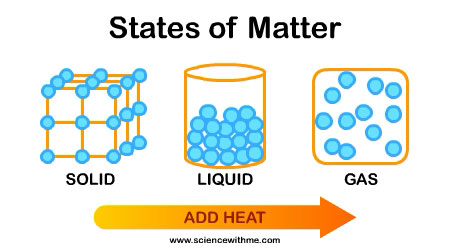Matter is anything that has volume and weight.
Everything on earth has volume and weight. That means everything on earth is matter! The amount of space something occupies is its volume. Solid items like tables, chairs and soccer balls, all take up space and therefore all have volume. Liquids like the water or milk you drink everyday or the water in a swimming pool also have volume. Even the air around us (which we cannot see but that we know is there) is made up of different gases and has volume.
What are the states of matter?
All materials fall into one of three categories: solids, liquids or gases. Each of these different groups has their own unique set of properties. Let us think about how we would categorize materials based on the following set of questions. Can a material change shape? Solids are difficult to squash and therefore generally keep the same shape. Liquids and gases on the other hand change shape to fill the container they occupy. Can a material flow? Solids don’t flow but liquids and gases do. Can a material change it’s volume? Solids and liquids don’t change much in volume. However it is easy to change the volume of a gas by squashing it. Matter exists and can be categorized as a solid, a liquid or a gas. We call these three forms of matter – the states of matter. Of the many different substances that exist, most are found as solids at everyday room temperature. Far less exist as either liquids or gases.
How do solids, liquids and gases differ?
All materials whether they are solids, liquids or gases are made up of tiny particles of matter which are far too small to see with the human eye. The way in which these particles are arranged determines whether the material is a solid, a liquid or a gas. What is a solid? In a solid the particles are packed so closely together that they are hardly able to move at all. This is why solids have a definite shape and don’t flow. Because the particles in a solid are packed so tightly a solid cannot be squished (compressed) easily into a smaller volume. It is not easy to compress, expand or change the shape of most solids because their particles are joined firmly to each other. A solid such as a pen cannot change into a completely different shape. There are some exceptions to this. For example materials like rubber can be easily stretched or bent without breaking even though rubber is a solid. What is a liquid? In a liquid the particles are also packed closely together but unlike solids the particles can move around each other. Particles in a liquid change places all the time. This is why liquids can flow very easily and because they have no definite shape of their own they always acquire the shape of the container in which they are held. A liquid will flow to the lowest point so it always fills the bottom part of a container first. Because their particles are packed closely together liquids, like solids, are difficult to squash (compress). What is a gas? A gas is mostly empty space. In a gas the particles are far apart and they move around easily. They spread out easily to fit any and all space available. Gases flow easily though this is more difficult to imagine because we usually cannot see a gas. Like liquids, because gases can flow they are also called fluids. It is easy to squish (compress) the particles of a gas more closely together so that is why it is easy to change the volume of a gas.
Can a material change from one state to another?
 When we refer to a substance as a solid, liquid or a gas we are talking about it under normal, everyday conditions. Many substances though can exits in all three states of matter. The most common of these substances and the one most people are familiar with is water. Water can exist as a solid (ice), a liquid (water) and a gas (steam). A change of state occurs when a substance changes from one state to another for example when ice melts into water. When ice melts it changes from a solid state into a liquid state. A change in state is normally caused by changes in temperature (ice melts when its temperature rises) but a change in state can also be caused by changes in pressure.
When we refer to a substance as a solid, liquid or a gas we are talking about it under normal, everyday conditions. Many substances though can exits in all three states of matter. The most common of these substances and the one most people are familiar with is water. Water can exist as a solid (ice), a liquid (water) and a gas (steam). A change of state occurs when a substance changes from one state to another for example when ice melts into water. When ice melts it changes from a solid state into a liquid state. A change in state is normally caused by changes in temperature (ice melts when its temperature rises) but a change in state can also be caused by changes in pressure.
Can matter be destroyed?
Matter cannot be created or destroyed – although it can change from one form to another. Scientists call this law the conservation of mass.
